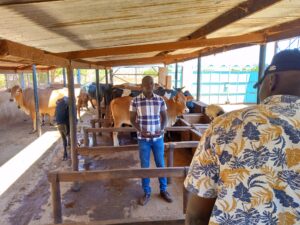Looking into Pastoralism’s Future: Youth lead the 2026 Vision for Pastoralist Youth Consultation
-
From
CGIAR Initiative on Livestock and Climate
-
Published on
14.11.22
- Impact Area

There was a buzz in the meeting hall at the University of Lukenya in Makueni County, about 5 hours’ drive south from Kenya’s capital city, Nairobi. Twenty-eight young pastoralists ages 18 to 35 from Kenya, Ethiopia, and Tanzania had gathered for three days in September 2022. Their mission was to contribute to the first of a series of consultations to develop a Vision for Pastoralist Youth, which will be launched during the International Year of Rangelands and Pastoralists 2026 (IYRP). The consultation focused on identifying pathways for pastoralism in the future including how pastoralism can adapt to the challenges of climate change.
In addition, the youth produced a statement that was presented at an official side event at the United Nations 27th Conference of Parties (COP27) in Egypt, which was attended by nominated youth pastoralist, Robha Abekeri (age 30) from Ethiopia.
Preserving an under-appreciated yet productive livelihood
All over the world, pastoralists derive their primary livelihood on rangelands that are estimated to cover more than 54% of the world’s land surface, most of which cannot sustain agricultural crops. They are significant contributors to countries’ economies, for example providing 90% of Mongolia’s agricultural GDP. In Africa alone, some 270 million pastoralists provide more than half of the continent’s meat and milk.
‘Pastoralists feed the world,’ said Robha Abekeri.
Pastoralists are also natural stewards of rangelands, providing important ecosystem services such as maintaining grasslands and carbon sequestration, maintaining and even increasing biodiversity, cycling nutrients and removing biomass to prevent fires. But pastoralism is facing increasing climate-related pressure and challenges–from unpredictable rainfall patterns to increased competition for pasture and other natural resources–putting the next generation of pastoralists at risk of losing this important source of livelihood. New opportunities of education and jobs in urban areas have meant many pastoralists are turning their back on pastoralism for seemingly better alternatives.
It is these very dilemmas that the youth at the consultation were determined to address. ‘Pastoralists everywhere face similar challenges,’ said Jacob Lekaitogo (age 25) from Kenya. ‘When we combine our efforts, our problems can be solved.’

Youth Leading the Conversation
The youth event was organized by researchers from CGIAR’s Livestock and Climate initiative in partnership with two youth empowerment organizations – the Climate Smart Agriculture Youth Network (CSAYN) and PROCASUR. Core objectives were to provide a forum for youth pastoralists to have their voices heard, share solutions and strategies that could be developed to ensure that youth are empowered in their communities, and build a critical mass of youth who are willing and able to influence the international climate change conversation to better include pastoralism.
Although the participants grew up in similar environments, they brought a range of expertise and perspectives resulting from different career trajectories. Tanu Gufu (age 32) from Yabello, Ethiopia, received her master’s degree in public management and now focuses on improving water systems in rural communities like her own, while Gideon Sway (age 25) from Mazimbu, Tanzania is a climate change trends data analyst and youth organizer for climate activism. All participants shared a commitment of continuing to engage with and support the pastoralist communities they come from.
The final statement of the youth participants calls for additional support and attention for rangelands and the communities that call these ecosystems home, as well as inclusion of youth pastoralist voices in policymaking decisions. It outlines the importance of linking indigenous pastoralist knowledge with modern science, and applying technology to better inform pastoralists of climate, livestock and crop trends. It also calls for transformation of livestock value chains to increase access and raise incomes for pastoralists, and the introduction of de-risking measures to incentivize pastoralist youth to stay in the business.
Linking with the 2026 International Year of Rangelands and Pastoralists
This event is the first of a series of visionary consultations with youth pastoralists across the world to create a series of statements in the lead up to the IYRP. The establishment of this special year was officially passed in a resolution by the United Nations General Assembly on 15 March 2022. This approval was the culmination of several years of advocacy from a global coalition including 300 pastoralist and supporting organizations, the International Livestock Research Institute (ILRI) and several UN agencies. The Government of Mongolia and 68 co-sponsoring countries developed and put forward the resolution.
The efforts to ensure involvement of youth are being led by CGIAR’s Livestock and Climate initiative, which looks at ways that livestock systems can adapt to climate change while improving nutritional security, reducing poverty, increasing social equity and socio-political security for communities.
‘Our priority is to include more women and youth in the identification and implementation of potential solutions,’ said Fiona Flintan, a senior scientist at ILRI who is leading the policy engagement activities of the initiative. ‘Part of that process is providing the platforms and outlets for their voices to not only be heard, but to be officially integrated within their communities and key regional and international fora.’
As this last consultation has shown, the pastoralist youth are ready and willing.
‘We are committed to improving the lives of pastoralists as a livelihood and cultural asset,’ said Farhiya Maalim (age 29) from Wajir, Kenya. ‘Pastoralism is the backbone of our territories, and we must work together to ensure its longevity in the face of climate change.’
Learn more: A 5-minute starter on rangelands and why they matter (Blog from Global Landscapes Forum)
Banner photo: Participants tour Mbooni Joy Farm in Makueni, County Kenya. Photo Courtesy of CSAYN
Story by Madison Spinelli, ILRI
Related news
-

Mapping for Resilience: How Spatial Data is Transforming Karamoja Cluster
Ibukun Taiwo02.07.25-
Climate adaptation & mitigation
Pastoral communities in the Karamoja Cluster (a region spanning Kenya, Uganda, South Sudan, and Ethi…
Read more -
-

Unlocking opportunities for youth through food systems transformation
Nathan Ronoh02.07.25-
Gender equality, youth & social inclusion
-
Youth
Youth are vital to the future of international agricultural, rural and urban development. As both…
Read more -
-

Building Resilience and Regeneration: The Central Highlands Ecoregion Foodscape (CHEF)
Sehlule Muzata02.07.25-
Climate adaptation & mitigation
At the CGIAR Sustainable Farming Program (SFP), we believe that collaboration is essential for trans…
Read more -
